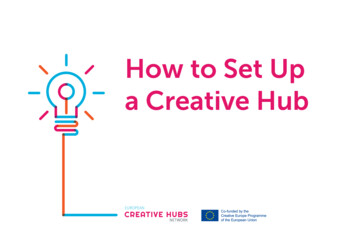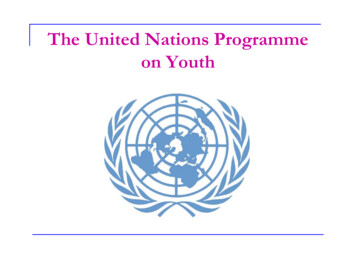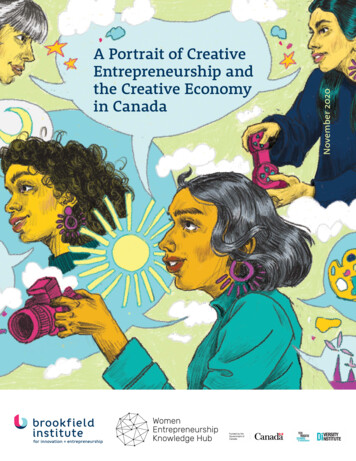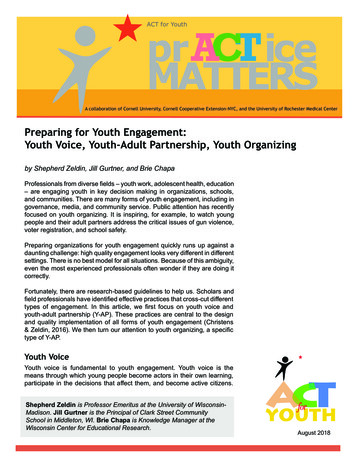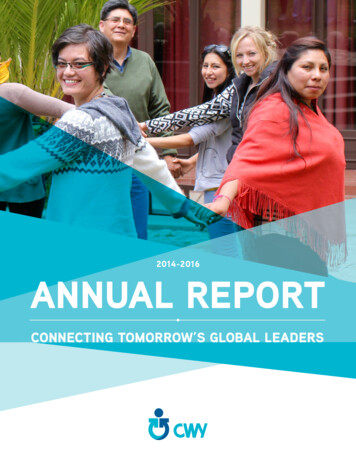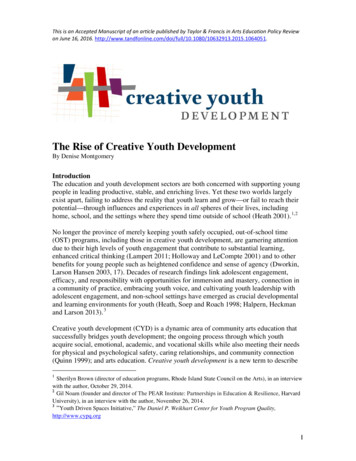
Transcription
This is an Accepted Manuscript of an article published by Taylor & Francis in Arts Education Policy Reviewon June 16, 2016. 13.2015.1064051.The Rise of Creative Youth DevelopmentBy Denise MontgomeryIntroductionThe education and youth development sectors are both concerned with supporting youngpeople in leading productive, stable, and enriching lives. Yet these two worlds largelyexist apart, failing to address the reality that youth learn and grow—or fail to reach theirpotential—through influences and experiences in all spheres of their lives, includinghome, school, and the settings where they spend time outside of school (Heath 2001). 1,2No longer the province of merely keeping youth safely occupied, out-of-school time(OST) programs, including those in creative youth development, are garnering attentiondue to their high levels of youth engagement that contribute to substantial learning,enhanced critical thinking (Lampert 2011; Holloway and LeCompte 2001) and to otherbenefits for young people such as heightened confidence and sense of agency (Dworkin,Larson Hansen 2003, 17). Decades of research findings link adolescent engagement,efficacy, and responsibility with opportunities for immersion and mastery, connection ina community of practice, embracing youth voice, and cultivating youth leadership withadolescent engagement, and non-school settings have emerged as crucial developmentaland learning environments for youth (Heath, Soep and Roach 1998; Halpern, Heckmanand Larson 2013). 3Creative youth development (CYD) is a dynamic area of community arts education thatsuccessfully bridges youth development; the ongoing process through which youthacquire social, emotional, academic, and vocational skills while also meeting their needsfor physical and psychological safety, caring relationships, and community connection(Quinn 1999); and arts education. Creative youth development is a new term to describe1Sherilyn Brown (director of education programs, Rhode Island State Council on the Arts), in an interviewwith the author, October 29, 2014.2Gil Noam (founder and director of The PEAR Institute: Partnerships in Education & Resilience, HarvardUniversity), in an interview with the author, November 26, 2014.3“Youth Driven Spaces Initiative,” The Daniel P. Weikhart Center for Youth Program Quality,http://www.cypq.org1
this segment of out-of-school time youth arts programs. 4 Young people in CYD programsexhibit high levels of artistic skill and accomplishment along with increased self-esteem,and sense of belonging (Heath and Roach 1999). CYD participants are immersed in abroad array of rigorous artistic endeavors, including creating documentary films,researching and reporting on community issues through radio broadcasts, writing andstaging new theatrical works, and engaging in thoughtful critique of one another’s visualart work. The impact for youth of program participation extends beyond pride in artisticaccomplishment. Throughout the United States, teen participants in CYD programs assertthat the programs saved their lives, putting them on positive trajectories and away fromgangs, drug use, crime, and ennui.This article provides a definition for the term creative youth development, describes corecharacteristics of CYD, and briefly describes four programs. It provides background onthe origins and history of creative youth development, including current advances in thefield and signs that the field is coalescing. The article describes creative youthdevelopment in the larger contexts of arts education and of education reform. Lastly, thepiece discusses policy, funding, and research needs and opportunities and providesquestions for consideration.A movement with historic roots, CYD is experiencing a catalytic moment with advancesin visibility, organizing, and knowledge. The field is uniting and building on research,publications, and model programs about the characteristics, approaches, impact, andoutcomes of quality CYD pr
4 The term creative youth development encompasses programs in the humanities and sciences in addition to the arts. The programs share a common purpose of positive youth development and common approach of youth gaining skills, experience, and knowledge through processes emphasizing creative inquiry and expression (Stevenson 2014).


